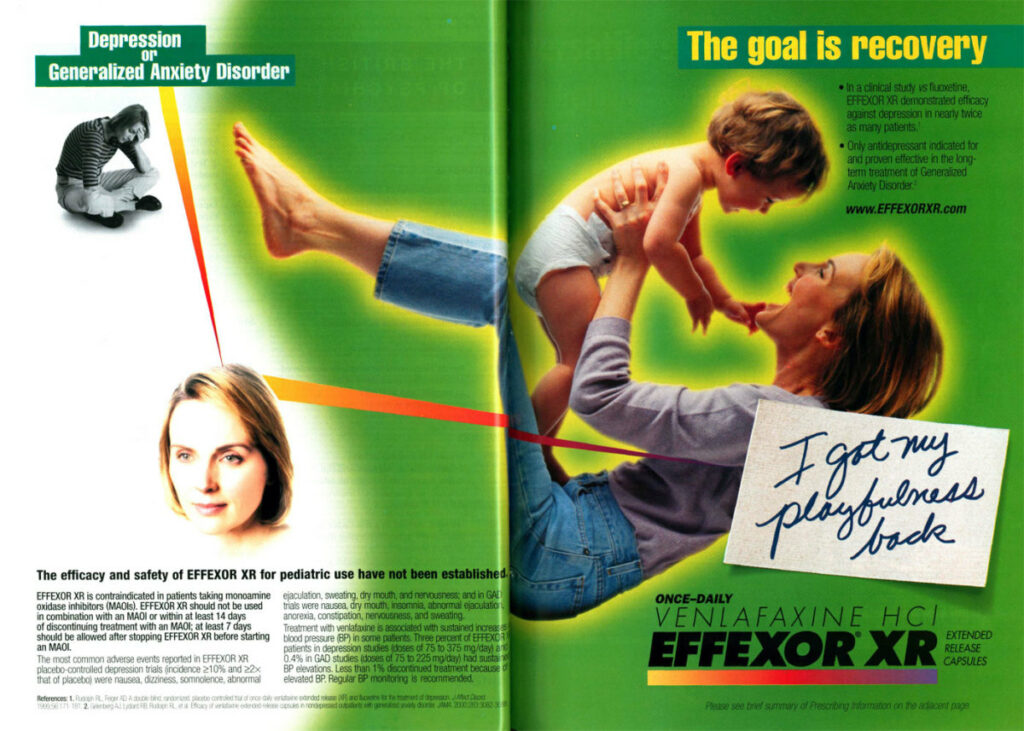A recent study published in Comprehensive Psychiatry investigated the representation of gender in direct-to-consumer pharmaceutical advertising (DTCPA), particularly for antidepressant ads. The study found a significant gender bias in these advertisements.
The lead researchers, Leila K. Asadi and Asim A. Shah from the Baylor College of Medicine, expressed their concerns about the potential adverse effects of these findings. They explain that DTCPA affects patient behavior, stating that while it aims to increase awareness of diseases and treatment options, it may also encourage the overutilization of drugs. In addition, they noted that women might be particularly vulnerable to this trend.
“Proponents of DTCPA claim that it empowers patients by providing increased awareness of diseases and treatment options … However, studies suggest that DTCPA may encourage overutilization of drugs,” Asadi and Shah write.
“Women are particularly susceptible to DTCPA because they are bigger consumers of healthcare services and are also more responsive to DTCPA. […] Notably, there appears to be a disproportionate number of women in antidepressant ads.”
 The researchers aimed to assess whether there was gender bias in pharmaceutical advertisements. They collected drug advertisement data from the past 20 years using AdPharm, an online database of pharmaceutical advertisements for depression (128 ads), psoriasis (226 ads), and diabetes (133 ads), as these were the most frequently advertised diseases. They then assessed each advertisement to determine whether the protagonist or patient was portrayed as male, female, or both and compared the data to the prevalence of the targeted disease among genders.
The researchers aimed to assess whether there was gender bias in pharmaceutical advertisements. They collected drug advertisement data from the past 20 years using AdPharm, an online database of pharmaceutical advertisements for depression (128 ads), psoriasis (226 ads), and diabetes (133 ads), as these were the most frequently advertised diseases. They then assessed each advertisement to determine whether the protagonist or patient was portrayed as male, female, or both and compared the data to the prevalence of the targeted disease among genders.
The results showed a significant gender disparity in antidepressant advertisements, with 82% of patients portrayed as women, 10.1% as men, and 7.8% as both genders. This misrepresentation is particularly notable given that the prevalence of depression (according to flawed epidemiological studies using screening instruments) among women and men is 58.3% and 41.7%, respectively.
Though nowhere near statistically significant, this was also the case for drug advertisements targeting psoriasis (50.4% women, 31% men, and 18.6% both genders) and diabetes (37.6% women, 35.3% men, and 27.1% both genders). However, unlike advertisements for antidepressants, the gender disparity in the promotions for psoriasis and diabetes was roughly similar to the disease prevalence distribution by gender.
The apparent disparity of gender in drug advertisements that far over-represents women and under-represents men can negatively impact individuals by reifying unhealthy social norms and perpetuating gender biases. The authors explain:
“While gender stereotypes are frequently used in advertising, their use to market medications is problematic since it has the power to define the illness and impact both the perceived prevalence of that illness in society […] The barrage of antidepressant DTCPA may persuade some women who do not suffer clinical depression to believe they have an illness that needs pharmaceutical treatment […]. In addition, the pervasive images of so many depressed women in antidepressant DTCPA perpetuate an outdated idea of female hysteria and promote the view that women are particularly susceptible to depression.”
Indeed, such misrepresentation in advertisements and news media is alarming as it can quickly impact how we view “mental illnesses.” The authors further note their concern about the challenges to fixing this misrepresentation:
“Improved regulations for DTCPA are clearly needed for the health and welfare of patients, but any attempts are likely to be strongly opposed by pharmaceutical companies. “
Perhaps future studies can explore why pharmaceutical companies spotlight women in their drug advertisements. Understanding the processes and mechanisms of advertisement design by pharmaceutical advertisements could provide insight into preventing gender biases.
****
Asadi, L. K., Shah, A. A. (2023) Gender bias in antidepressant direct-to-consumer pharmaceutical advertising. Comprehensive Psychiatry. 123. https://doi.org/10.1016/j.comppsych.2023.152384 (Link)















DTCPA should be made illegal again, especially since most of the pharmaceutical industry’s advertising has been lies, which means those ads have been – and are – illegal … from a female marketing major, long time psychopharmacological researcher, and “expert” by experience.
Report comment
They target women because it seems women are far more likely to ask their doctor. Plus our culture insists that when women have “emotions” that we just need antidepressants and mental health care. Women are so heavily targeted. A man can be passionate about a subject and a women if she behaves the same way about the topic as the so called passionate man she is called words that should never be repeated because they are not kind to say about anyone. There is a double standard in our society.
Report comment
What world do these researchers live in?
Report comment
It used to be barefoot and pregnant. Now it’s drugged and compliant.
“Mother’s little helper”: Vintage Drug Ads Aimed at Women, goretro.com
Report comment
It seems the more things change, the more they stay the same:
“Mother’s Little Helper: The History of Valium”, historyhit.com
Report comment
Psychiatry needs to go the way of the girdle.
Report comment